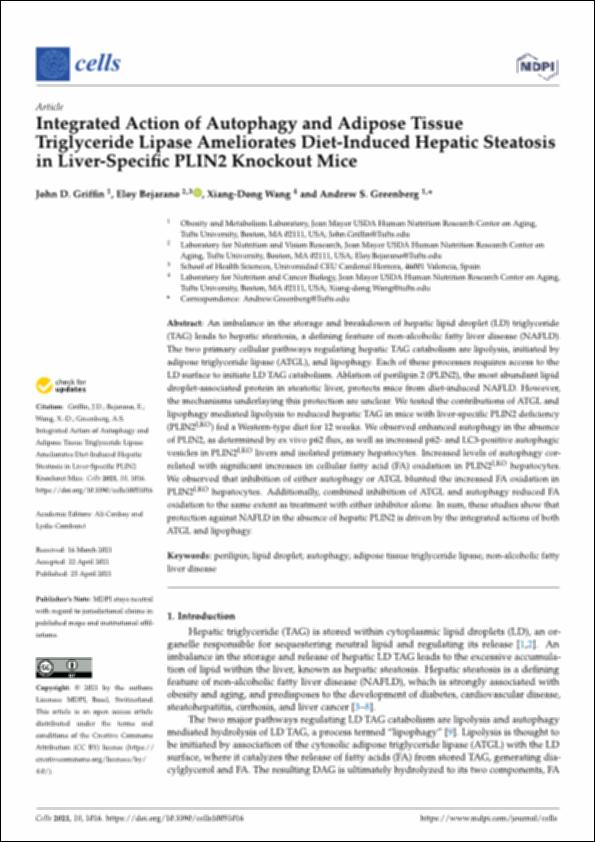Please use this identifier to cite or link to this item:
http://hdl.handle.net/10637/13615Integrated action of autophagy and adipose tissue triglyceride lipase ameliorates diet-induced hepatic steatosis in liver-specific PLIN2 knockout mice
| Title: | Integrated action of autophagy and adipose tissue triglyceride lipase ameliorates diet-induced hepatic steatosis in liver-specific PLIN2 knockout mice |
| Authors : | Griffin, John D. Bejarano Fernández, Eloy Wang, Xiang-Dong Greenberg, Andrew S. |
| Keywords: | Tejido adiposo - Aspectos moleculares.; Adipose tissues - Molecular aspects.; Lipasa.; Proteínas - Uso terapéutico.; Lipase.; Hígado - Enfermedades - Tratamiento.; Liver - Diseases - Treatment.; Triglicéridos.; Triglycerides.; Proteins - Therapeutic use. |
| Publisher: | MDPI |
| Citation: | Griffin, J. D., Bejarano, E., Wang, X. D. & Greenberg, A. S. (2021). Integrated action of autophagy and adipose tissue triglyceride lipase ameliorates diet-induced hepatic steatosis in liver-specific PLIN2 knockout mice. Cells, vol. 10, i. 5 (25 apr.), art. 1016. DOI: https://doi.org/10.3390/cells10051016 |
| Abstract: | An imbalance in the storage and breakdown of hepatic lipid droplet (LD) triglyceride (TAG) leads to hepatic steatosis, a defining feature of non-alcoholic fatty liver disease (NAFLD). The two primary cellular pathways regulating hepatic TAG catabolism are lipolysis, initiated by adipose triglyceride lipase (ATGL), and lipophagy. Each of these processes requires access to the LD surface to initiate LD TAG catabolism. Ablation of perilipin 2 (PLIN2), the most abundant lipid droplet-associated protein in steatotic liver, protects mice from diet-induced NAFLD. However, the mechanisms underlaying this protection are unclear. We tested the contributions of ATGL and lipophagy mediated lipolysis to reduced hepatic TAG in mice with liver-specific PLIN2 deficiency (PLIN2LKO) fed a Western-type diet for 12 weeks. We observed enhanced autophagy in the absence of PLIN2, as determined by ex vivo p62 flux, as well as increased p62- and LC3-positive autophagic vesicles in PLIN2LKO livers and isolated primary hepatocytes. Increased levels of autophagy correlated with significant increases in cellular fatty acid (FA) oxidation in PLIN2LKO hepatocytes. We observed that inhibition of either autophagy or ATGL blunted the increased FA oxidation in PLIN2LKO hepatocytes. Additionally, combined inhibition of ATGL and autophagy reduced FA oxidation to the same extent as treatment with either inhibitor alone. In sum, these studies show that protection against NAFLD in the absence of hepatic PLIN2 is driven by the integrated actions of both ATGL and lipophagy. |
| Description: | Este artículo se encuentra disponible en la siguiente URL: https://www.mdpi.com/2073-4409/10/5/1016 Este artículo pertenece al número especial "Highlights in Autophagy: From Basic Mechanisms to Human Disorder Treatments". |
| URI: | http://hdl.handle.net/10637/13615 |
| Rights : | http://creativecommons.org/licenses/by/4.0/deed.es |
| ISSN: | 2073-4409 (Electrónico) |
| Issue Date: | 25-Apr-2021 |
| Center : | Universidad Cardenal Herrera-CEU |
| Appears in Collections: | Dpto. Ciencias Biomédicas |
Items in DSpace are protected by copyright, with all rights reserved, unless otherwise indicated.


